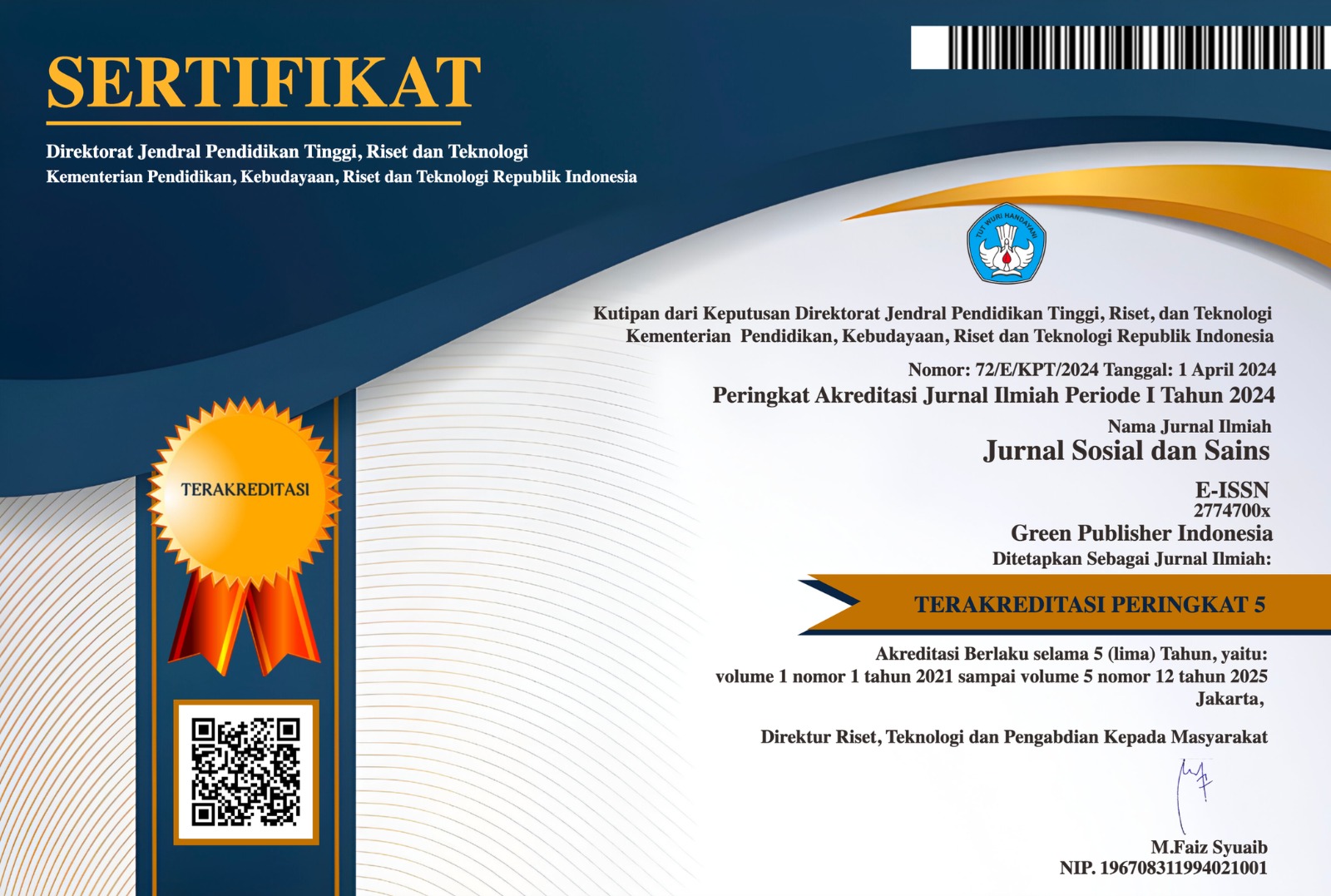Kiai Pesantren Leadership in Internalizing the Independence Attitude of Students
DOI:
https://doi.org/10.59188/jurnalsosains.v3i11.1061Keywords:
Pengetahuan, Pencegahan ISPA, BalitaAbstract
Background: Indonesia is one of the countries that is prone to earthquakes, especially tectonic earthquakes, because of its geographical location between three large plates. As an Indonesian society, studying natural phenomena from an early age is very important. Therefore, the involvement of educated young people is needed to minimize the impact of earthquakes. Stacked (Stacko for Education) is present as a learning medium for earthquake disaster preparedness based on card games derived from paper waste. The Uno card comes from recycled paper. After that, paper is used to print cards containing questions about earthquake disaster preparedness.
Purpose: The purpose of this study is to identify and analyze programs, program implementation, elaborate on internalization and contribution, leadership impact, program evaluation and supporting and inhibiting factors of kiai pesantren efforts in internalizing the independence attitude of students.
Method: The approach chosen in this study is a qualitative approach with analytical descriptive methods.
Results: shows that: First, the kiai leadership program consists of learning programs, training programs and practice in the field. Second, the implementation of the program is carried out by providing exemplary attitudes, providing motivation, and instilling positive behaviors, especially in the individuals of students. Third, internalization and contribution of kiai leadership by adhering to the values of honesty through, candid and objective speech impacts the attitudes and behaviors of saritri to be honest not manipulative, especially in entrepreneurship. Fourth, the impact is the growth of the spirit of independence of students through the management process of pesantren education to foster and realize the independence attitude and entrepreneurial skills of students. Fifth, program evaluation is carried out through non-attitude scale tests. Sixth, Inhibiting factors, there is a public view that pesantren are not to give birth to entrepreneurs but to produce scholars, the lack of resources (human and natural), equipment, raw materials and capital / finance pesantren, lack of partnership institutions and business capital pesantren. And the supporting factors, there are: support of facilities and infrastructure; support from kiai and ustadz for their students to become independent students; through education and training; The learning process from the pesantren experience that began with direct practical activities in the field students also wanted to follow in the footsteps of the founder kiai.
Conclusion: Pesantren as an education provider has advantages compared to other educational institutions.
References
Antoncic, B., & Hisrich, R. D. (2001). Intrapreneurship: Construct refinement and cross-cultural validation. Journal of Business Venturing, 16(5), 495–527.
Dian Nafi, M. (2007). Praksis Pembelajaran. Yogyakarta: PT. LKSI Pelangi Aksara.
Haekal, M. H., & Audah, A. (2009). Sejarah Hidup Muhammad (2nd ed.). Pustaka Jaya.
Harisah, A. N. (2018). Pesantren Multikultural: Alternatif Pendidikan di Era Milenial. Al-Fikr: Jurnal Pendidikan Islam, 4(2), 1–9.
Kartono, K. (2017). Indikator-indikator Kepemimpinan.
Kriyantono, R. (2019). Public Relation Writing Edisi ke-2. Kencana Prenada Media Group.
Mitra, O., & Ahmad, B. (2017). Pembaharuan Pendidikan Pesantren. Islamika: Jurnal Ilmu-Ilmu Keislaman, 17(2), 56–74.
Mulyadi, E., Yuniarsih, T., & Supardan, D. (2016). The Analysis of Social Teachers’ Performance in the Senior High Schools of Ciamis Regency. Journal of Education and Practice, 7(24), 6–14.
Muttaqin, R. (2016). Kemandirian dan pemberdayaan ekonomi berbasis pesantren (studi atas peran Pondok Pesantren Al-ittifaq Kecamatan Rancabali Kabupaten Bandung terhadap kemandirian eknomi santri dan pemberdayaan ekonomi masyarakat sekitarnya). JESI (Jurnal Ekonomi Syariah Indonesia), 1(2), 65–94.
Nuraeni, N., Sukandar, A., & Helmawati, H. (2022). Dampak Gaya dan Peran Kepemimpinan Kiai dalam Penguatan Karakter Disiplin Santri. Edukasi: Journal of Educational Research, 2(1), 14–32.
Rachman, W. O. N. N., Syafar, M., Nasir, S., Amiruddin, R., Ahmad, A. K., & Abdullah, M. T. (2022). Drugs Abuse Behavior Prevention Model through Family Approach in Adolescents in Kendari City. Biomedical and Pharmacology Journal, 15(3), 1497–1502.
Rakhmat, J. (2015). Metode Penelitian Komunikasi, Penerbit PT. Remaja Rosadakarya, Bandung.
Sanusi, U. (2012). Pendidikan kemandirian di pondok pesantren. Jurnal Pendidikan Agama Islam-Ta’lim, 10(2), 123–139.
Sugiyono. (2015). Metode Penelitian Pendidikan. Bandung. Metode Penelitian Pendidikan (Pendekatan Kuantitatif, Kualitatif, Dan R&D), 308.
Sukmadinata, N. S. (2010). Pengembangan model pembelajaran terpadu berbasis budaya untuk meningkatkan apresiasi siswa terhadap budaya lokal. Cakrawala Pendidikan, 2, 81228.
Sukmadinata, P. D. N. S. (2000). Filsafat dan Teori Pendidikan Pemikiran untuk Membangun Masyarakat Indonesia Baru. Jakarta: Makalah pada Konvensi Nasional Pendidikan Indonesia.
Takdir, M. (2018). Modernisasi kurikulum pesantren. IRCiSoD.
Umam, W. (2020). Kepemimpinan Kiai dalam Mengembangkan Pondok Pesantren. Attractive: Innovative Education Journal, 2(3), 61–69.
Us, K. A. (2010). Kepemimpinan kiai pesantren: studi terhadap pondok pesantren di kota jambi. Kontekstualita: Jurnal Penelitian Sosial Keagamaan, 25(2), 37095.
Wibowo, U. B. (2011). Teori kepemimpinan. Badan Kepegawaian Daerah Kota Yogyakarta [Skripsi].[Internet].[Diunduh 26 September 2017]. Tersedia Pada: Http://Staff. Uny. Ac. Id/Sites/Default/Files/Tmp/C, 20201113.
Wiyatno, W., & Muhyadi, M. (2013). Peran Kompetensi Kewirausahaan Kepala Sekolah Dalam Peningkatan Mutu Pendidikan Di Smp N 3 Jetis, Bantul. Jurnal Akuntabilitas Manajemen Pendidikan, 1(1), 162–174.
Published
How to Cite
Issue
Section
License
Copyright (c) 2023 Said Harismansyah, Nina Nurmila, Irawan Irawan, Bambang Samsul Arifin

This work is licensed under a Creative Commons Attribution-ShareAlike 4.0 International License.
Authors who publish with this journal agree to the following terms:
- Authors retain copyright and grant the journal right of first publication with the work simultaneously licensed under a Creative Commons Attribution-ShareAlike 4.0 International (CC-BY-SA). that allows others to share the work with an acknowledgement of the work's authorship and initial publication in this journal.
- Authors are able to enter into separate, additional contractual arrangements for the non-exclusive distribution of the journal's published version of the work (e.g., post it to an institutional repository or publish it in a book), with an acknowledgement of its initial publication in this journal.
- Authors are permitted and encouraged to post their work online (e.g., in institutional repositories or on their website) prior to and during the submission process, as it can lead to productive exchanges, as well as earlier and greater citation of published work.








